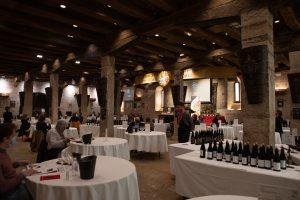
На сайте используются cookie файлы
The site uses cookie files
Данный сайт имеет возрастное ограничение!
This site has age restrictions!
Я подтверждаю, что мне, увы, уже давно исполнилось 18 лет
This year, on March 19, the 107th Tastevinage exhibition was held at the Château du Clos de Vougeot with the presentation of 680 Burgundy wines. The jury-tasters selected 201 wines which compile 29.56% of the presented wines.
107 red wines, 70 white wines and 24 Crémant de Bourgognes are awarded at the 107th Tastevinage. As a result, the badge pasted on the bottle allows the domain or prize winner to keep their label.
In Burgundy, there are mainly two grape varieties. Pinot Noir is used to make red Burgundy wine with sweet raspberry, cherry, and strawberry flavors, while Chardonnay is used for Chablis and Burgundy white wine. Although among the red varieties it is also worth mentioning Gamay which is used for red Macon and Beaujolais. Among whites, a small number of Aligote and Pinot Blanc varieties grow here, and Sauvignon grows exclusively in the San Brie region.
There is a special classification of Burgundy wines: appellations Régionales (name of the region), appellations Villages (name of the village), Premiers Crus (first class), Grands Crus (upper class). Of all Burgundy wines, Grands Crus accounts for only 1% of the total wine volume, Premiers Crus – 10%. The monks from Citeaux were not mistaken in determining the terroirs and climates of Burgundy when they assigned all the vineyards surrounding the Château du Clos de Vougeot to the Grands Crus class.

In addition to the traditional classification, there is the Tastevinage quality brand of Burgundy wines. The organizer is the Confrérie des Chevaliers du Tastevin whose mission is to popularize everything from Burgundy, in particular its great wines and traditional cuisine, as well as to revive holidays, festivals, customs, and folklore of the region, and to develop tourism in Burgundy.
The tasted wines ranged from Chablis to Mâconnais, from the appellations of the Régionales to the Grand Cru, including Crémant de Bourgogne sparkling wines. This selection is rigorous, and the winning percentage is a testament to the severity of the selection.
The large Cistercian cellar of Château du Clos de Vougeot brought together a jury of more than 250 tasters, selected from an elite of connoisseurs of fine taste: renowned winemakers, wine merchants, leaders of viticulture associations, brokers, oenologists, restaurateurs, government officials working in partnership with the wine industry, enthusiastic and knowledgeable wine drinkers, all surrounded by Confrérie officials and journalists present as “independent observers”. At each table, dozens of wines, presented anonymously, without mentioning the manufacturer or the merchant, are subjected to a rigorous organoleptic examination which lasts almost two hours.
The questions that judges should ask themselves are very precise. Does the wine live up to its name and harvest? Is it typical and will it improve with age? In other words, would I be happy to have this wine in my cellar and proudly serve it to my friends? Immersed in their work, the tasters evaluate wines in religious silence under the watchful but strictly neutral observation of the Confrérie organizers whose job it is to make sure everything goes smoothly.
Photographer: Bénédicte Manière
12.12.2025
27.11.2025